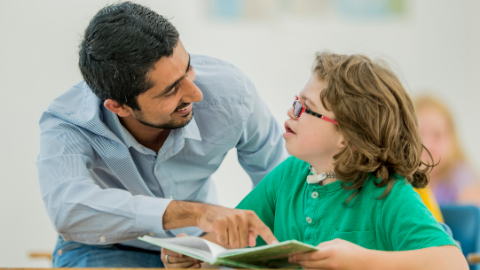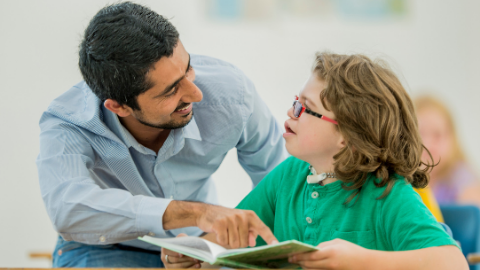
Ten steps to implementing LGBT-inclusive RSHE

Follow these steps to map out an LGBT-inclusive approach to RSHE, from first steps to ongoing monitoring and evaluation. Read the steps in order or choose the ones that are most relevant to the work you’re doing in your setting.
1: Be clear on what the statutory guidance says
Make sure you know what the DfE’s statutory guidance on RSHE says about LGBT inclusion.
Primary schools must teach …
…about different families, which the statutory guidance specifically states can include LGBT parents. The DfE has stated that while it is not obligatory that they do so, ‘primary schools are strongly encouraged and enabled’ to cover LGBT content when teaching about different families.
Secondary schools must teach …
...about ‘the facts and the law about sex, sexuality, sexual health and gender identity in an age-appropriate and inclusive way. All pupils should feel that the content is relevant to them and their developing sexuality’.
A good place to look for resources to help you plan and deliver your provision is Annex B to the statutory guidance by the DfE, which lists suggested resources, including resources by Stonewall and others.
2: Understand what LGBT pupils and those with LGBT parents or carers might need
In lots of instances, what you teach in RSHE will be the same for all pupils, whether they’re LGBT or not – for example, all pupils need to learn about consent, including the age of consent and the importance of asking for and giving consent.
Sometimes LGBT pupils or those with LGBT family members will need specific information that’s relevant to their experiences, or the experiences they may go on to have.
Use research, best practice guides and resources to help staff develop their understanding of how LGBT pupils’ needs might be different from non-LGBT pupils’. Try our Introduction to Supporting LGBT Children and Young People and our School Report 2017.
3: Assess how LGBT inclusive your current provision is
Consider whether all of your RSHE teaching is LGBT-inclusive, including teaching on families, healthy relationships, online safety, physical and mental health, as well as sexual health and intimate relationships (for secondary schools and primary schools choosing to teach sex education).
A good question to ask yourself as you review your provision is: would an LGBT pupil at this school, or a pupil with LGBT family members, see themselves reflected in this teaching?
Good questions to ask yourself as you review topics and lesson plans are:
- How would an LGBT pupil’s experiences around this topic be different to the experiences of their peers who aren’t LGBT?
- How would their experiences be the same?
- What specific information would an LGBT pupil need to be taught during this lesson/topic so that they can make healthy, informed choices? You can ask yourself the same question for pupils with LGBT family members.
- Check to see whether you’re introducing pupils to a diverse range of LGBT people, including LGBT people of colour, LGBT disabled people and LGBT people of faith. For example, see our Trans Day of Visibility posters, our role model posters for UK Disability History Month and our Black History Month lesson plans for primary schools, secondary schools and colleges and special schools.
Consulting with pupils and staff
- Set up a focus group with pupils, asking what pupils think works well about your LGBT-inclusive RSHE provision and what could be improved. Consult with older and younger year groups and compare and contrast pupils’ experiences as they move through the school.
- Don’t forget to consult with staff and school leadership, including Governors or Trustees. Compare and contrast feedback from leaders and other staff with feedback from pupils.
4 Build a developmental and timely LGBT-inclusive curriculum
- The statutory guidance states that: ‘At the point at which schools consider it appropriate to teach their pupils about LGBT, they should ensure that this content is fully integrated into their programmes of study for this area of the curriculum rather than delivered as a standalone unit or lesson’. Ensure you’re integrating LGBT content rather than teaching it only as a separate lesson. Take a developmental approach, returning to and expanding on topics as pupils grow in age and maturity.
- Ensure that resources such as photos, diagrams, videos, drawings and illustrations reflect a variety of relationship types and gender expressions, as well as reflecting a range of body types, ethnicities and visible disabilities.
- Consider using inclusive language when writing social stories to support understanding for pupils with SEND – for example, using language like ‘most girls have periods’ instead of ‘all girls have periods’ when writing social stories about menstrual hygiene; or making sure that you include examples of a young person with two mums or two dads when writing social stories about different types of families and relationships.
- Look at how you use repetition to support pupils’ understanding throughout the school year and as pupils move up through the school – this may be particularly relevant for pupils with SEND. Using posters around the school, such as our Widigt symbol posters, our Different Families posters or our ‘Some People Are…’ posters, can be a helpful way to keep conversations going.
- Developing an LGBT-inclusive curriculum across all subject areas supports you to expand on LGBT topics and themes – our curriculum guides for primary and secondary can help you map out an inclusive curriculum for your age phase.
5: Equip staff with training and support
- Take some time to understand how confident staff feel delivering LGBT-inclusive RSHE. Consider asking staff to rate their confidence out of 10. Ask staff what would build their confidence further. Look for training or resources that will address the needs staff have identified. Stonewall has a range of e-learning courses which can help staff explore different aspects of supporting LGBT children and young people.
- Consider providing opportunities for team teaching, so that less confident colleagues can learn from those who are more confident or experienced.
6: Ensure your RSHE policy is LGBT inclusive
- Include a summary of what you teach and when, and explain that you are fulfilling your duties under the Equality Act 2010, which include supporting LGBT pupils to participate fully in school life.
- Be sure that your policy meets all of the requirements set out in the statutory guidance on RSHE.
- You can also use your policy to explain why LGBT-inclusive RSHE is important to the school. For example, you may wish to point out that your LGBT-inclusive RSHE provision is part of:
- a whole-school approach to LGBT inclusion;
- your work to tackle prejudice-based bullying;
- the ways in which you ensure all pupils feel included and represented at school, and learn how to treat people who are different to them with respect.
7: Engage parents and carers to help everybody understand what your LGBT-inclusive approach looks like
- The statutory guidance on RSHE from the DfE requires all schools to have consulted with parents and carers on RSHE. Effective parental engagement can be an important part of developing LGBT-inclusive RSHE. The DfE, along with the NAHT, ASCL and NGA, have produced some guidance on how to engage with parents and carers.
- It’s important to know that according to the DfE:
‘Schools ultimately make the final decisions and engagement does not amount to a parental veto. The Department for Education will back schools that, having engaged with parents and carefully considered their views, take reasonable decisions about their Relationships Education policy.’
- Give parents and carers opportunities to look at your lesson materials and examples of pupils’ work throughout the school year: you could do this via your website, your newsletter, or – in the case of storybooks or visual materials – through school displays. Seeing what RSHE looks like in context can build parent and carer confidence that LGBT people, families and relationships are reflected in your teaching.
8: Monitor and evaluate your provision
- Use different assessment techniques to check pupils’ learning over time – the Sex Education Forum’s Monitoring, Evaluating and Assessing RSE – the basics has lots of useful tips.
- Provide a variety of ways for both pupils and teaching staff to evaluate your LGBT-inclusive RSHE provision – consider using evaluation surveys, anonymous evaluation boxes, or having group discussions in lessons or form time.
9: Ensure the way you teach is LGBT inclusive, as well as the content that you teach
- Take time to explain the meaning of key terms. You’ll find child-friendly definitions in the glossary at the end of our guide on Creating an LGBT-inclusive Primary Curriculum.
- Remember that LGBT people are as diverse as any other group, and it’s important to avoid stereotyping LGBT people and relationships.
- Make sure you know how to provide support if a pupil tells you that they are LGBT. Stonewall’s Introduction to Supporting LGBT Children and Young People has lots of advice about how to support a pupil who is coming out.
- Spend some time considering what questions pupils might have on LGBT topics and how you might answer these.
10: Embed LGBT inclusion beyond the classroom
Building a whole school culture of celebrating difference can enhance your LGBT-inclusive RSHE provision. Building staff knowledge and confidence ensures that pupils have regular opportunities to revisit and reflect on topics across the curriculum and wider school life.
You’ll find lots of helpful advice and information in Stonewall’s Getting Started toolkits for EYFS, primary and secondary.